The diagram below shows a pendulum having a bob of mass 80 g. A and C are extreme positions and B is the mean position. The bob has velocity 5 m/s at position B. Assuming there is no loss of energy, select the correct statements from the options given below: [g = 10 N/kg]
![The diagram below shows a pendulum having a bob of mass 80 g. A and C are extreme positions and B is the mean position. The bob has velocity 5 m/s at position B. Assuming there is no loss of energy, select the correct statements from the options given below: [g = 10 N/kg]](https://d10lpgp6xz60nq.cloudfront.net/physics_images/OSW_GRU_SQP_ICSE_X_SM1_PHY_QP_E01_030_Q01.png)
At point A the bob will have only kinetic energy.
The maximum potential energy gained by the bob will be 1000J
The maximum height 'h' reached by the bob will be 125 cm.
At point D the bob will have maximum kinetic energy.
At point A the bob will have only kinetic energy. Explanation: At A & C the KE=0 so this statement is incorrect.
The maximum potential energy gained by the bob will be 1000 J. Explanation: Maximum PE will be when KE = PE
mgh=1/2mv2
h=v22g=5×52×10=2520
PE=mgh=0.080×10×2520=1J
This statement is incorrect.
The maximum height .k. reached by the bob will be 125 cm.
Explanation: Maximum height =2520=54=1.25m=125cm
Hence this statement is correct.
4. At point D the bob will have maximum kinetic energy. Explanation: At point C and point A potential energy will be maximum. When the bob moving from C to A, it has maximum kinetic energy at point B. Hence the statement incorrect. 5. The maximum potential energy gained by the bob will be 1J . Explanation: Maximum PE = I J, Hence this statement is correct. 6. At point B the energy possessed by the bob is 1000 J. Explanation: At B, KE=12mv2=0.040×5×5=1JandPE=0 Only KE will work and maximum KE = 1J So this is incorrect.
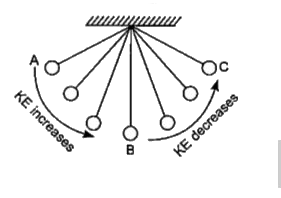
Topper's Solved these Questions
Similar Questions
The figure below shows a simple pendulum of mass 200 g. It is displaced from the mean position A to the extreme position B. The potential energy at the position A is zero. At the position B the pendulum bob is raised by 5 m.
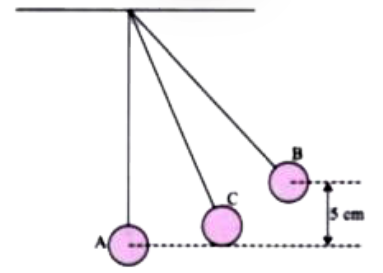
(i) What is the potential energy of the pendulum at the position B?
(ii) What is the total mechanical energy at point C?
(iii) What is the speed of the bob at the position A when released from B ?
(Take g = 10ms−2 and there is no loss of energy.)
View SolutionA pendulum has length L = 1.8 m. The bob is released from position shown in the figure. Find the tension in the string when the bob reaches the lowest position. Mass of the bob is 1 kg.
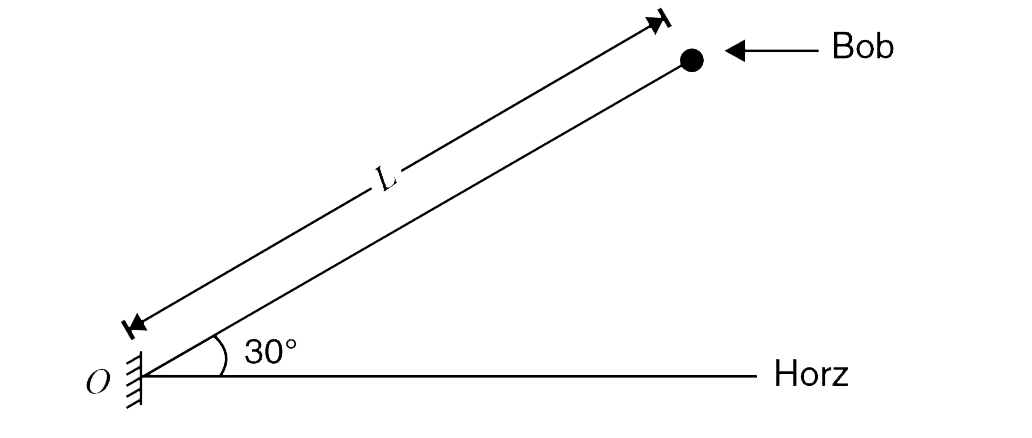
View Solution
Knowledge Check
A simple pendulum with a bob of mass m oscillates from A to C and back to A such that PB is H. IF the acceleration due to gravity is g, the velocity of bob as it passes through B is
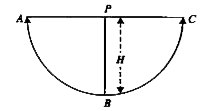 AzeroB2g HCmghD√(2gH)
AzeroB2g HCmghD√(2gH)For a simple pendulum in simple harmonic motion, which of the following statements is/are correct?
1. The kinetic energy is maximum at the mean position.
2. The potential energy is maximum at the mean position.
3. Acceleration is maximum at the mean position. Select the correct answer using the code given below: Code:A1 onlyB2 onlyC1 and 3D2 and 3A simple pendulum with a bob of mass m oscillates from A to C and back to A such that PB is H. If the acceleration due to gravity is g, then the velocity of the bob as it passes through B is
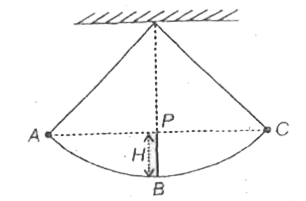 AmgHB√2gHCZeroD2gH
AmgHB√2gHCZeroD2gH
Name the type of energy possessed by the bob of a simple pendulum when it is at (a) the extreme position, (b) the mean position, and (c) between the mean and extreme positions
View SolutionThe hanging bob of a simple pendulum is displaced to one extreme position B and then released. It swings towards centre position A and then to the other extreme position C. In which position does the bob have :
(i) maximum potential energy ?
(ii) maximum kinetic energy ?
Give reasons for your answer.
View SolutionA simple pendulum with a bob of mass m oscillates from A to C and back to A, such that PB=h,

If the acceleration due to gravity is 'g', then the velocity of the bob as it passes through B is
View SolutionMass of the bob of a simple pendulum of length L is m. If the bob is projected horizontally from its mean position with velocity √4gL, then the tension in the string becomes zero after a vertical displacement of
View SolutionWhat is the velocity of the bob of a simple pendulum at its mean position, if it is able to rise to vertical height of 10 cm (take g=9.8m/s2)

View Solution
